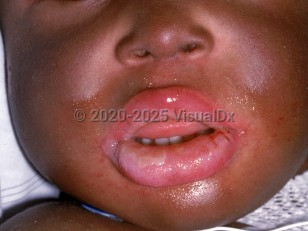Chediak-Higashi syndrome in Child
Alerts and Notices
Important News & Links
Synopsis

Chediak-Higashi syndrome is a multisystem immunodeficiency disorder characterized by recurrent infections, oculocutaneous albinism, and neurologic problems (nystagmus, photophobia, peripheral neuropathy, seizures, problems in the spine and cerebellum). The defective gene, LYST, is usually inherited in an autosomal recessive fashion. Chediak-Higashi syndrome presents in early childhood. Neutrophils have impaired chemotaxis, intracellular killing, and natural killer cell function. LYST mutations are thought to modify toll-like receptor modulated immune responses, increasing susceptibility to infection. Death in childhood may occur due to infections, infantile-onset hemophagocytic syndrome, or an accelerated lymphoma-like phase that occurs in 80% of patients.
It is now understood that the clinical findings and complications associated with Chediak-Higashi syndrome occur on a spectrum; thus, not every patient has all the findings, complications, or mortality associated with the classic description. The dichotomy is between what is considered typical versus atypical Chediak-Higashi syndrome. The latter may have more progressive neurologic consequences and focal or generalized hyperpigmentation as defining features. Moreover, the hematologic sequelae of Chediak-Higashi syndrome are less morbid, if present, in its atypical form. Cutaneous and systemic AA amyloidosis is an additional finding in older patients with all forms of Chediak-Higashi syndrome.
It is now understood that the clinical findings and complications associated with Chediak-Higashi syndrome occur on a spectrum; thus, not every patient has all the findings, complications, or mortality associated with the classic description. The dichotomy is between what is considered typical versus atypical Chediak-Higashi syndrome. The latter may have more progressive neurologic consequences and focal or generalized hyperpigmentation as defining features. Moreover, the hematologic sequelae of Chediak-Higashi syndrome are less morbid, if present, in its atypical form. Cutaneous and systemic AA amyloidosis is an additional finding in older patients with all forms of Chediak-Higashi syndrome.
Codes
ICD10CM:
E70.330 – Chediak-Higashi syndrome
SNOMEDCT:
111396008 – Chediak-Higashi syndrome
E70.330 – Chediak-Higashi syndrome
SNOMEDCT:
111396008 – Chediak-Higashi syndrome
Look For
Subscription Required
Diagnostic Pearls
Subscription Required
Differential Diagnosis & Pitfalls

To perform a comparison, select diagnoses from the classic differential
Subscription Required
Best Tests
Subscription Required
Management Pearls
Subscription Required
Therapy
Subscription Required
References
Subscription Required
Last Reviewed:05/17/2022
Last Updated:06/22/2022
Last Updated:06/22/2022
Chediak-Higashi syndrome in Child

